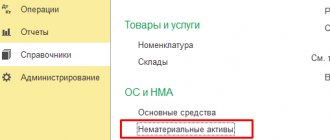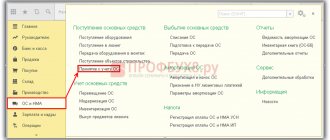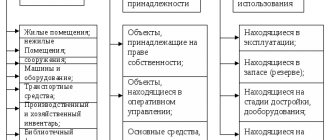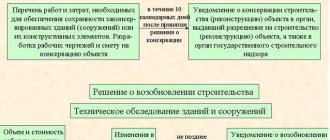ACCOUNTING FOR INTANGIBLE ASSETS
1. Intangible assets are accounting objects:
a) those that do not have a material form, but bring constant or long-term income;
2. Intangible assets differ from fixed assets:
b) the absence of a material form;
3. The following are not taken into account as part of intangible assets:
e) costs of purchasing a license.
4. The initial cost of intangible assets acquired for payment is:
c) the amount of actual acquisition costs.
5. The composition of costs included in the initial cost of intangible assets depends on:
a) the option of entering the organization;
6. Expert assessment as the initial cost is used for:
c) intangible assets received free of charge.
7. Intangible assets received by organizations as a contribution to the authorized capital are assessed:
c) contract price.
8. The inventory value of intangible assets is:
c) the purchase price of the object together with the costs of bringing it to a state suitable for use.
9. Depreciation on intangible assets in accounting is calculated:
b) by law;
10. When calculating depreciation rates for intangible assets using the straight-line method, the following are taken into account:
a) initial cost and useful life;
11. When calculating depreciation based on the reducing balance method, the following are taken into account:
b) residual value and useful life;
12. Write-off of the residual value of the sold item of intangible assets is reflected as part of:
b) expenses for other operations;
13. In case of early disposal of intangible assets, the residual value is taken into account as part of:
c) other expenses.
14. Depreciation on intangible assets for non-production purposes is reflected by the entry:
b) D-t sch. 91 “Other income and expenses”
K-t sch. 05 “Amortization of intangible assets”;
15. The amount of organizational expenses recognized as a contribution to the authorized capital is repaid by the organization within:
16. Identical options for calculating depreciation on intangible assets in accounting and tax accounting:
d) linear option.
17. Intangible assets revalued:
b) are not exposed.
18. The transfer of intangible assets as a contribution to the authorized capital is reflected in the account:
c) 58 “Financial investments”.
19. The debt of buyers for an object of intangible assets sold to them that was previously in operation is reflected in the accounting entry:
b) D-t sch. 62 “Settlements with buyers and customers”
K-t sch. 91 “Other income and expenses”;
20. The value of the rights acquired to an object of intangible assets in exchange for other property is reflected in the accounting entry:
b) D-t sch. 60 “Settlements with suppliers and contractors”
K-t sch. 62 “Settlements with buyers and customers”;
21. For intangible assets for accounting purposes, for which it is impossible to determine the useful life, depreciation rates are established based on:
22. Expenses associated with the formation of an organization, recognized in accordance with the constituent documents as a contribution (contribution) of the participants (founders) of the organization to its authorized (share) capital, are reflected as part of:
Intangible assets in Russian and international practice
In this situation, enterprises are looking for ways to increase their competitiveness. To do this, they use different methods - reducing costs and prices by reducing production costs, developing new and more improved types of goods, active advertising, etc. One of these methods is the acquisition and creation of intangible assets, which provide protection for the production technologies used in the enterprise and allow reducing costs through innovation, existing knowledge, skills, rights, signs and technologies. These assets allow enterprises to consolidate their competitive advantages and thus protect them from unfair competition.
From a legislative point of view, intangible assets include intellectual property. This term forms the basis of part four of the Civil Code of the Russian Federation (hereinafter referred to as the Civil Code of the Russian Federation), according to which intellectual property is the result of intellectual activity and equivalent means of individualization of legal entities, goods, works, services and enterprises that are provided with legal protection. Article 1226 of the Civil Code of the Russian Federation also introduces the concept of “intellectual right”, which includes a set of rights to protected results of intellectual activity, including property rights, personal non-property rights (the right of authorship, the right to a name) and other rights (the right to create, the right of access, etc.) .d.). According to this interpretation, the owner of an intellectual right has the right to use and dispose of the result of intellectual activity, as well as prohibit other persons from using the results of his intellectual activity. This approach is based on the principle that the content of intellectual right includes two powers – use and disposal. However, the concept of “use of the result of intellectual activity” is not disclosed in the Civil Code of the Russian Federation.
The state provides legal protection of the exclusive right to certain objects of intellectual activity and means of individualization, but this requires their state registration. In this case, information about the copyright holder and the intellectual property object is entered into a special register. For example, information on trademarks is contained in the State Register of Service Trademarks, data on patents is contained in the State Register of Inventions.
However, there are intangible assets that do not require state registration. The main thing in relation to such objects is the existence of a formal right to receive income from them and to control the ability of others to derive similar benefits from them. Examples of such objects are objects of related rights, commercial designations and know-how. The last object - know-how - is of great interest, because the copyright holder must introduce a trade secret regime in relation to them. Otherwise, such assets are not considered intellectual property. A trade secret regime can be established if all the measures listed in Federal Law No. 98-FZ “On Trade Secrets” have been taken. Documents containing classified information are marked “Trade Secret” and the owner of the secret is indicated. This law also lists information that is not a trade secret - information about wages, environmental pollution, fire safety, sanitary-epidemiological and radiation conditions, food safety and other factors.
In relation to such an asset as “know-how”, legislative and regulatory acts do not contain a direct answer to the question of what documents can serve as the basis for recognizing know-how as an object of intellectual property. However, an analysis of Article 1465 of the Civil Code of the Russian Federation and established arbitration practice allows us to conclude that the existence of rights to know-how can be confirmed by a set of documents confirming the fact of its existence and compliance with the conditions of its legal protection. This kit may include:
- a) documents in which the corresponding result of intellectual activity is expressed - technological maps, drawings, descriptions of methods, recipes, instructions, etc.;
- b) documents confirming the commercial value and novelty of the production secret - the conclusion of the expert commission;
- c) documents confirming the fact of establishing a trade secret - a provision on a trade secret, an order from a manager establishing the regime of access to know-how, etc.
An analogue of an object of intellectual property in the accounting of organizations is the concept of “intangible asset”. The documents regulating the accounting procedure for intangible assets include PBU 14/2007 “Accounting for intangible assets”. This provision does not define the concept of an intangible asset, but there is a list of conditions under which an object can be accepted for accounting as such an asset:
- the object is capable of bringing economic benefits to the organization when performing work, providing services and for management needs;
- the organization has the right to receive economic benefits (properly executed documents confirming the existence of the asset itself and the rights to it) and control over the object;
- the ability to separate (identify) an object from other assets;
- a useful life exceeding 12 months or an operating cycle that exceeds 12 months;
- the organization does not intend to subsequently sell the property;
- the actual cost of the object can be determined;
- the absence of a material form in an object.
If an object does not satisfy at least one of the listed criteria, then it is not an intangible asset. Having analyzed these conditions, we can give the following “accounting” definition of intangible assets - these are objects created or acquired by an organization that are used in economic activities for a period exceeding 12 months, have a monetary value, have the ability to alienate and generate income, but are not materially material values. It should be noted that, in general, the concept of intellectual property is similar to the concept of intangible assets, however, you need to understand that the concept of “intellectual property” is a concept of civil law, which relates not only to the field of accounting. If an object of intellectual property is considered in the context of accounting, before recognizing this object as an intangible asset, it is necessary to make sure that it meets all the criteria listed above.
PBU 14/2007 provides examples of objects that, if the recognition conditions are met, are intangible assets:
- a) works of science, literature, art;
- b) computer programs;
- c) inventions and utility models;
- d) selection achievements;
- e) know-how;
- f) trademarks and service marks;
- g) business reputation.
However, this list contains intangible assets for which not all recognition conditions are met. Let's look at the example of know-how for which state legal protection is not provided. To recognize an object of know-how as an intangible asset, it is necessary that there be properly executed documents confirming the organization’s right to this object. At the regulatory level, such a document is not provided, i.e. A situation arises in which the organization will not be able to accept the object for accounting as intangible assets. One solution to this problem may be to collect a package of documents listed above, which confirm the existence of the object and its protection at the level of the organization itself.
Attention
This article is participating in the Best Article Competition
.
The winner will receive the main prize - 30,000 rubles!
Find out more about the competition
In connection with the entry into force of PBU 24/2011 “Accounting for the costs of developing natural resources”, intangible exploration assets for which there is confidence in obtaining commercial benefits in the future were added to the list of intangible assets. Such assets are the right to carry out work on the search, evaluation of mineral deposits and (or) exploration of mineral resources, confirmed by the presence of an appropriate license, acquired geological information, etc. In addition, PBU 24/2011 certifies the legality of reflecting licenses for the use of subsoil as part of intangible assets, although there is no such object in the list of intangible assets in PBU 14/2007; such an exception is provided only for subsoil user enterprises.
For accounting purposes, goodwill is determined by calculation as the difference between the purchase price paid to the seller when acquiring an enterprise as a property complex, and the sum of all assets and liabilities on the balance sheet on the date of its purchase. In this regard, goodwill can be either positive (the excess of the purchase price over the value of assets on the balance sheet) - a premium to the price for expected future economic benefits, or negative (the excess of the book value of assets over the purchase price) - a discount on the price due to with the absence of factors of the presence of stable buyers, reputation for quality, marketing and sales skills, and business connections. At the same time, only positive business reputation is an object of intangible assets, since it meets the condition for obtaining future economic benefits.
In the list of examples of intangible assets in PBU 14/2007, in addition to know-how, there are objects that in practice do not always fully meet the conditions for recognition. For example, computer programs, databases, topologies of integrated circuits have a tangible form, which contradicts the conditions for recognizing an object as intangible. Also, the object of intangible art is works of science, literature and art, although these objects are protected not by patent, but by copyright. They are not subject to state registration, they are not issued with a certificate or patent with a certain period of use, and it is impossible to restrict access to them by third parties. In addition, they have an expressed material form in the form of a public work, performance or image, sound and video recording, etc., therefore, when accepting such objects for accounting, certain difficulties arise.
Such ambiguous concepts and unclear formulations lead to the fact that each accountant interprets this provision independently, so some authors propose not to apply the rule of simultaneous compliance with all seven conditions for recognizing an object as an intangible asset in accounting. To accept an asset as an intangible asset, you can use the asset recognition criteria in accordance with IFRS, according to which it is necessary that the object is identifiable, the organization controls the resource, its value is reliably determined and it brings economic benefits to the organization. Control in this case does not necessarily imply the presence of security documents, as required by PBU 14/2007.
Unlike Russian standards, IFRS defines the concept of an intangible asset. According to IAS 38 Intangible Assets, intangible assets are identifiable non-monetary assets that do not have physical form. To recognize an object as such, three conditions must be met:
- a) identifiability - the asset is separable, that is, it can be separated from the enterprise, sold, transferred, licensed, leased or exchanged, and the object is the result of contractual or other legal rights;
- b) presence of control - an enterprise controls an asset if it has the right to receive future economic benefits, and can also limit the access of others to these benefits;
- c) the likelihood of obtaining future economic benefits - receipt of revenue from the sale of products, works, services, as well as cost reduction or other benefits received from the use of an intangible asset by the enterprise.
Let's compare the conditions for recognizing an object as intangible assets according to Russian and international standards in Table 1.
Table 1. Comparative characteristics of the conditions for recognition of intangible assets in RAS and IFRS
| Criterion | Conditions of acceptance according to PBU 14/2007 | Conditions for adoption under IFRS 38 |
| Ability to provide future economic benefits | The object is capable of bringing economic benefits to the organization (used in the production of products, provision of services, for management needs) | An asset is a resource from which future economic benefits are expected to flow to the organization. |
| Control over the object | The organization has the right to receive economic benefits (availability of appropriate documents) that this object may bring in the future and control over the object | An entity controls an asset if it has the right to receive the economic benefits flowing from the underlying resource and can restrict others' access to those benefits. |
| Possibility of identification | An object is separated or separated from other assets | The definition of intangible asset requires its identification, which would make it possible to clearly distinguish it from business reputation |
| Duration of use | Use exceeding 12 months or operating cycle exceeding 12 months | Not installed |
| Sales Assumption | No sale expected within 12 months or an operating cycle exceeding 12 months | Not installed |
| Reliability of determination | The actual (initial) cost of the object can be reliably determined | An intangible asset should be recognized if the cost of the asset can be measured reliably |
| Material structure | The object lacks a material structure | An intangible asset is an asset that does not have a physical form. |
Based on the presented comparison, we can conclude that part of the regulation of an object’s belonging to intangible assets in PBU 14/2007 is similar to IFRS. However, in accordance with PBU 14/2007, the presence of control over intangible assets must be accompanied by documentary registration of rights to the object, as discussed above, and IFRS does not provide for strict requirements for the registration of legal rights to intangible assets. However, IAS 38 implicitly states that for some assets - staff skills, market share and customer lists - it is desirable to have legally enforceable rights, and then these assets can be considered intangible. For example, with regard to the skills of personnel, IAS 38 states that an entity generally does not have sufficient control over the expected future economic benefits arising from the presence and training of skilled personnel to recognize them as an intangible asset. However, at the same time, it is noted that special managerial or technical talent can be recognized as an intangible asset in the case where the enterprise has legally enforceable rights to use and control it. The same conditions apply to relationships with clients - if an enterprise has a legally enforceable right to protect relationships with a client from third parties or other forms of control over these relationships, then this object can be recognized as an intangible asset.
IFRS 38 provides more clearly than PBU 14/2007 the criteria for identifying an intangible asset. In addition to those listed above, it can be noted that an object is identifiable if it arises from contractual or other legal rights, regardless of whether those rights are transferable or separable from the entity or other rights and obligations.
However, despite this, many experts argue that the moment an object is recognized as identifiable is controversial, and if an accountant doubts the criteria for classifying an object, then it must be recognized as an expense of the period in which it arises. Table 2 presents a list of objects related to intangible assets and expenses of the period according to the criteria of IFRS 38.
Table 2. List of objects related to intangible assets and expenses of the period
| Objects accounted for as intangible assets | Items accounted for as period expenses |
| Brand names and names | |
| Copyright | Author's advances |
| Commitment not to compete | Organizational expenses |
| Licenses, franchises | Emission costs |
| Business reputation (prestige) | Marketing research expenses |
| Patents | Expenses for personnel training |
| Trade marks | Court expenses |
| Technologies, recipes, drawings, formulas | R&D cost |
| Computer and software | — |
As can be seen from the table, the line separating intangible assets from period expenses is uncertain.
It should be noted that despite the recognition of IFRS in Russian accounting, at the moment there is no uniformity in the interpretation of intangible assets in IFRS and PBU 14/2007. This is due to the fact that the list of intangible assets in PBU 14/2007 is based on the provisions of part four of the Civil Code of the Russian Federation, and therefore, for example, only property rights to computer programs, but not rights of use, can be classified as intangible assets, but in IFRS Intangible assets include both property rights to software and rights to use them.
The same example can be given in relation to licenses, which, according to Russian legislation, are not recognized as intangible assets regardless of the period of their use, since licenses are not covered by property rights. The criterion of the existence of a property right is not included in the scope of regulation of complex intellectual property objects, which include several results of intellectual activity. According to the Civil Code of the Russian Federation, an organization for such objects can combine both property and non-property rights. For example, these could be custom-made websites or computer programs.
The condition of the absence of a material form is present in both positions. However, some intangible media are transmitted in tangible form - the program is stored and transmitted on disks. According to Russian accounting standards, the intangible asset itself must be accounted for separately from its tangible carrier, while in IFRS the organization itself determines, based on the professional judgment of the accountant, which element - content (intangible asset) or tangible form - is more significant. Depending on this, the object will be recognized as either a fixed asset or an intangible asset.
The difference in the approaches of Russian standards and IFRS is also observed regarding business reputation. In Russian accounting, goodwill, which can only be obtained through the acquisition of a business, is an intangible asset, while IFRS introduces an identifiability criterion for an intangible asset to separate it from goodwill. Under IFRS, goodwill arising in a business combination is a separate asset that will generate future economic benefits as a result of synergies between the acquired assets, which in themselves and individually cannot be recognized as intangible assets. Goodwill is a separate asset from an intangible asset and is governed by IFRS 3 Business Combinations. Goodwill created within the company should not be recognized as an intangible asset, because it is not identifiable and cannot exist separately from the enterprise.
Based on the considered types of intangible assets, we will classify them according to individual criteria in Table 3:
Table 3. Classification of intangible assets
| Classification feature | Essence of the characteristic | Names of intangible assets |
| Purchase method | 1.Purchase 2.Creation on your own | 1. Licenses, franchising. 2. Patents (not recognized by IFRS), trademarks (not recognized by IFRS), know-how. |
| Separability into an independent accounting unit | 1. Separable assets 2.Inseparable assets | 1. Trademarks, patents, copyrights. 2. Business reputation (goodwill) |
| Exchangeability | 1. Assets for sale 2. Unsaleable assets | 1. Patents, trademarks 2. Goodwill |
| Period of receipt of expected benefits | 1. Period determined by economic circumstances 2. Period determined by legal restrictions | Varies for individual intangible assets |
There are also differences in the approach to defining an intangible asset in tax accounting. The Tax Code of the Russian Federation provides the following definition of intangible assets: – “results of intellectual property acquired or created by a taxpayer (exclusive rights to them), used in the production of products or for the management needs of an organization for a long time (over 12 months).” The conditions for recognizing intangible assets for accounting are practically the same as in PBU 14/2007, that is, in general, the interpretation of the essence of the conditions for recognizing intangible assets in accounting and tax accounting is the same, the only exception is that the rules of the Tax Code do not provide for control over the use of the asset. There is also a slight difference in the composition of intangible assets in tax accounting - in the list of intangible assets in the Tax Code of the Russian Federation there is no business reputation, but there is an additional object - the cost of a license agreement (license) for the right to use subsoil. However, since January 1, 2009, organizations have been given the right to write off the costs of concluding a license agreement evenly over 2 years for other costs associated with production and sales. The chosen method of accounting for such expenses of the organization must be fixed in the accounting policy for tax purposes.
Galiullina Alisa
How do intangible assets differ from fixed assets?
To understand how intangible assets differ from fixed assets, let's consider each concept separately.
According to clause 5 of PBU No. 6, fixed assets are recognized as real estate, namely: buildings, structures, land plots. In addition, fixed assets include equipment, various instruments and devices, computers, transport, production tools, livestock, perennial plantings, etc. Also included in fixed assets are capital investments and property used on the basis of long-term lease relationships.
Assets will be taken into account if a number of conditions are simultaneously met:
- used in production or for administrative needs;
- used for more than a year;
- will generate income for the company;
- there are no plans to implement them.
Intangible assets do not have a natural form. According to PBU No. 14, intangible assets will include exclusive rights to authorship and patents (their value is taken into account), as well as long-term investments of the company.
As well as fixed assets and intangible assets, it is necessary to have a period of use of more than a year, as well as the likelihood of generating income for the company in the future.
Inventory of fixed assets and intangible assets
An inventory of fixed assets and intangible assets is carried out based on the order of the head of the company or upon inspection by the tax authorities. A special commission is being created for this purpose. During the inventory the following is checked:
- availability and correct completion of primary documentation for commissioning and operation;
- condition of cards and other analytical accounting registers;
- correct reflection of the primary cost of objects;
- correct reflection of data on the movement of fixed assets and intangible assets on accounts.
When unaccounted for fixed assets are identified, they are classified as non-operating profit received in kind. If a shortage of intangible assets or assets is detected, then it is necessary to identify the guilty employees. When these are not established or the court refuses to compensate for losses, the shortage is written off as production costs or a decrease in funds.
Write-off of intangible assets
Let's look at how to write off intangible assets in the Enterprise Accounting program. To do this, use the document “Write off intangible assets”, which is located in the menu item “OS and intangible assets”.
Let's create a new document and consider what necessary details will need to be filled out. We select an organization if several are kept in the database. Then select intangible assets and indicate in the document in the field “Other income and expenses” - “Other unrealized income and expenses”.
We carry out and check document postings.






